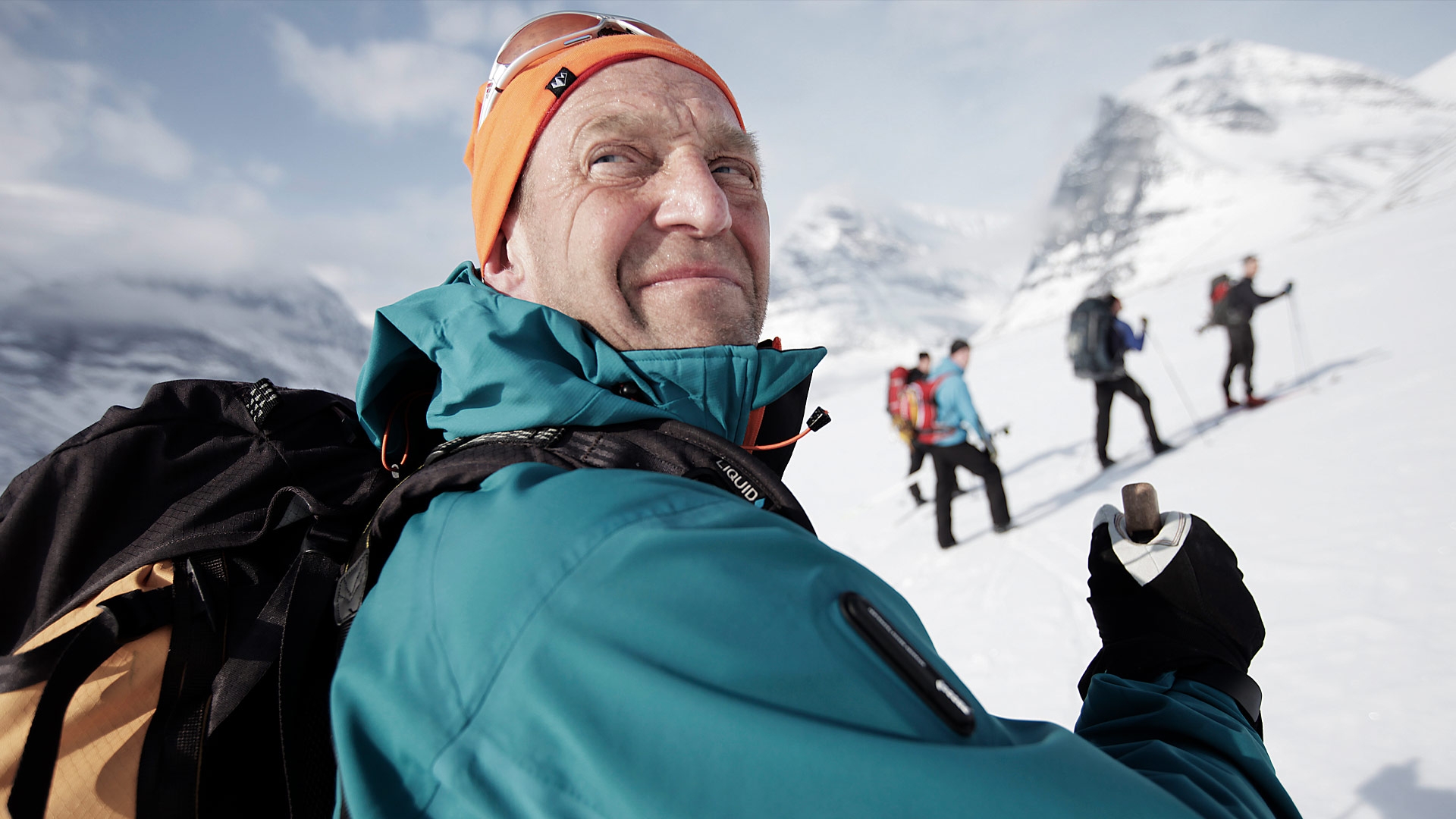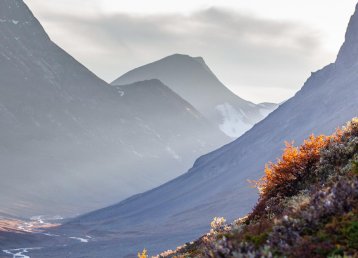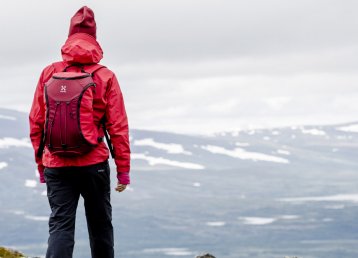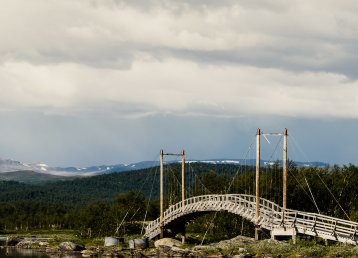It was the middle of April, and the year was 2013. My childhood friend Jonas and I travelled by car from Piteå up to the end of the road at the tourist station in Nikkaluokta. This trip took five hours, and the best part was near the end of it, in the shape of a definite change in the landscape as the surrounding mountains started to pile up higher and higher against the sky. The atmosphere started feeling like an adventure, and we got more and more curious as we approached our destination.
We have always been quite active outdoor people, my friend Jonas above all, and this is why I’m slightly reluctant to write about our journey between Nikkaluokta and Kebnekaise mountain station… because it was undertaken on snowmobiles. The trip was pleasant and comfortable, in the custom-made sledges that could seat up to six people and their bags. But it’s the loss of prestige in taking the easy road rather than going on skis that bug me now, after the fact.
As for the mountain station, I didn’t really know what to expect. My strategy normally is to keep expectations low and perhaps end up surprised; guard myself against any disappointment. But Kebnekaise mountain station was no disappointment. I’m always fascinated by any larger complex located in very remote and unexpected places. The mountain station was bigger than expected but had kept the right atmosphere, and the standard was good.
On the way
Once we’d arrived, we met two familiar faces from Piteå. One was the mountain guide Clas-Jörgen Pohl and the other Mikael Lundberg, who used to be a professional cyclist. After checking in and installing ourselves in the cosy rooms, a stone’s throw from the main building, we went looking for the restaurant. Like most people and living beings, I like food. Perhaps I’m a bit of a food nerd. The White Guide logo by the restaurant entrance at the mountain station told us that we had a food-related experience coming up. And a couple of hours later, it was in our stomachs. An interesting and ambitious three-course dinner where a carrot soup served as a starter is the detail that first springs to mind afterwards.
After a good – but as usual, a bit too short – night’s sleep, the calendar now indicated ‘D-Day’. I could sense some butterflies in my stomach thinking about the unknown: would the weather play along with us all the way to the summit? How much hard work would it actually take? And above all: would I make it? The previous night we’d been sat in the lobby at the mountain station, and there we got talking to yet another two guys from Piteå. This happens a lot with people from the city in question. Since these gentlemen had the same ambitions as us with their trip to Kebnekaise, we decided to team up.
And finally, there we were: in the yard outside the station, making a first push on the poles on our journey towards the roof of Sweden. The weather couldn’t have been better. It was a glorious spring morning with good conditions for alpine skiing. We chose the so-called ‘West Track’ rather than the East, which might be shorter but harder going.
Judging distances
The first stretch we traversed towards the very picturesque mountain Duolbagorni/Tolpagorni. It’s a steep mountain, 1,662 metres high and with a very characteristic crater on top. In my world, a mountain like Duolbagorni is emblematic of the alpine region.
One tricky thing in mountain terrain is judging distances. What looks like a couple of football pitches is, in actual fact, several kilometres. This became really obvious as we travelled from the mountain station up the so-called ‘Cauldron Valley’, which took a lot longer than I had expected. Here it got steeper, and the extra-wide climbing skins I’d bought combined with my lack of experience of this kind of skiing proved to be a mix that made itself known and felt. Another detail that made it difficult was that temperatures rose and what started out as powder snow was now sticking to the skis.
As the terrain got steeper and steeper, my heart beat faster and faster.
As the terrain got steeper and steeper, my heart beat faster and faster, which meant a very wet base layer. It felt like I had a lump of cement fastened to each leg as I tried to keep up with the rest of the group. The feeling was worrying, seeing how this was just a short and early part of the trip.
Once we reached the first glacier, it was finally time to leave the skis behind, heavy with snow, and change into crampons. They are a kind of metal frame with spikes underneath that you fasten to your boots or ski boots. It was the first time I used crampons, and it was a positive experience to feel how well they worked, ascending the steep, snow-clad track up the mountain Vierramvare. After an hour or so walking with crampons in the steep terrain, we reached the summit of Vierramvare.
Also read
Stories told with namesThe weather
The weather that had so far consisted of sun and blue skies had suddenly changed to wind and fog. We all appreciate different things, and I belong to those who think this was an interesting turn of events. Everyone got more focused, and we had to grab the GPS to make sure we didn’t veer off course. This is even more important when you’re in an area with lots of steep drops and cornices.
Once we got past the summit, the terrain descended towards the so-called ‘Coffee Valley’, which was also our last stop before the final ascent towards the summit. As far as I’m told, it’s in Coffee Valley most people decide whether to push on or turn back. The latter alternative would have been a disappointment considering all the hard work we’d already done. And also, if that had been the decision we made, I wouldn’t have been able to finish this story.
At least the weather gods were with us, and after we’d stopped for some well-needed nourishment, the clouds broke. We could finally start our final ascent to the summit.
The vertical metres we’d finished that morning started to make themselves felt as we travelled steeply up the southern slope of Kebnekaise. Our water bottles were empty, and we had to stop every now and then to eat snow – something I’ve been told since I was a child not to do, to avoid the risk of tapeworm and other things. But necessity knows no law, and if you’re thirsty, you’re thirsty. It proved to be absolutely safe.
Get started
Kebnekaise/Giebmegáisi is Sweden’s highest mountain; the south peak reaches about 2096 meters above sea level. Despite its location in the wild, just at the foot of the mountain, Kebnekaise Mountain Station has offered visitors refuge and rests for more than a century. And not only are comfortable beds and a hot meal on offer – there is even a bakery located in one of the buildings – the perfect starting point for a mountaineering excursion. The road ends in Nikkaluokta, 19 km from Kebnekaise, and the last bit is travelled by foot or skis if you’re up for it. If you want to save your energy, there are other means of transportation such as snowmobile in the winter and helicopter in the summer.
On top of Sweden
Our curiosity rose as we approached the summit, and I got more and more eager to see it: the highest point in Sweden. On the way up, we came across another interesting feature. We found the highest outdoor toilet in Sweden by one of the summit cabins. And it wasn’t really the outdoor toilet per se that was interesting; it was more the state of it. To put it simply: someone who really needed it had to begin visiting the country’s highest toilet by shovelling snow for half an hour. Because the door had been left open and it was absolutely packed full of snow.
And then, finally, it came and went: the final ridge. The place that I had been thinking about and fantasied about at times since I was a child was suddenly in view, right in front of my eyes. The fascinating thing about that sight was that it was actually a proper peak – a kind of large and pointed pile of snow right there on top of the mountain.
The final hundred meters felt like nothing, and you could sense the group’s emerging joy. When the final climb was behind us, and we found ourselves on the South Summit itself, there was cheering and the obligatory high fives. The weather was absolutely amazing, with clear blue skies and a view that stretched as far as the eye could see in all directions.
We’d made it! And somewhere inside a niggling feeling of being stressed, that you had to experience as much as possible now that you were there. On top of Sweden.
Heading back
Once our efforts had been immortalised, and once we’d taken on as many impressions and feelings from this visit to the summit, we possible could it were time to start the long journey back. When we went past the previously mentioned summit cabin, we had a final break for food and drink. We also melted snow on a gas stove to fill our water bottles.
On our way up from Coffee Valley, once again over the Vierramvare mountain, my friend Jonas and I made a trade that taught me an important lesson. When we changed from skis to crampons earlier that day, I had lent Jonas my poles because one of his had broken as we travelled up the first glacier. Surely that couldn’t make much difference?
That difference did indeed prove to be important. Sure, our group consisted of two ex-mountain riflemen, the previously mentioned guide Pohl, the professional cyclist Lundberg and my friend Jonas who has done the Vasa Race on skis. So no small wonder I’d been lagging behind during the day. But now, being able to use my arms to push and help after having walked using crampons only proved to be a revolutionary change for my stamina and body.
Once we’d descended to the skis, we had a wonderful finish to the day skiing down in the light of the reddish afternoon sun. This was absolutely one of the best parts of the trip, to be able to glide down in peace and quiet, listening to the wind sing and process the experiences we’d had during the day. We came back to the mountain station before dark, and I was so incredibly tired. Naive as I’d been, I’d been picturing how we’d celebrate by means of various beverages and sit in front of the fire in the lobby to talk about the day we’d had.
Instead, we enjoyed a delicious and much-needed dinner without talking much at all. A quick visit to the shop where we all bought the t-shirt and then straight into the nicest bed in the world. Who would have guessed that title would go to a simple bunk bed?



































